WJEC AS Biology Unit 2.4 - Adaptations for Nutrition
1/133
There's no tags or description
Looks like no tags are added yet.
Name | Mastery | Learn | Test | Matching | Spaced |
|---|
No study sessions yet.
134 Terms
Heterotrophs
Organism that requires a source of orgaic molecules produced by autotrophs for their nutrition
Examples; animals, fungi, some Protoctista and some bacteria
Saprotrophs
Organism that feeds on dead and decaying matter by extracellular digestion
secrete distive enzymes out of the body then absorb the soluble products across the cell membranes
Example of heterotrophs
Examples; all fungi, some bacteria and the mould Rhizopus
Process of saprotrophic nutrition in fungi
secretion of digestive enzymes from hyphae
extracellular digestion of dead organic matter
enzymes digest the substrate (the matter on which the fungus grows and feeds)
absorption of small soluble products of digestion
products transported through mycelium
Autotrophs
Organisms that use simple organic molcules to synthesise complex organic compunds for their nutrition
Examples; green plants/autotrophic bacteria
Two types; chemoautotrophs and photoautotrophs
Photoautotrophs
form of autotroph
use light energy as a soure of energy to synthesise complex organic food materials
Chemoautotrophs
form of autotroph
organism that use chemical energy from inorganic molecules to synthesise complex organic food materials
examples; prokaryotes
Holozoic
example of heterotrophic nutrition
organism which feed on solid organic material synthesised by autotrophs which is then digested internally to form smaller soluble molecules for absorption
method of most animals
internal digestion of food substances
examples; herbivores, carnivores, omnivores, detritivores
process of holozoic nutrition
ingestion; food is taken into the body, usually through the mouth
digestion; the breakdown of small, insoluble food molecules into small, soluble food molecules
absorption; the uptake/passage of soluble food molecules and ions across cell membanes through the gut wall into the capillaries or lacteals
assimilation; the uptake and use of soluble food molecules by cells in the body
Herbivores
animals that feed solely on plant materials
Carnivores
animals that feed on other animals
Omnivores
animals which feed on both animals and plant materials
Detritiovores
animals which feed on dead and decaying materials
Mutualism
a close association/interaction of/between organisms from more than one species, in which they both benefit from the relationship
example; digestion of cellulose by microroganisms in the gut of a herbivore
Parasite
an organism which lives on or in another organism, the host, obtaining nutritents from it, at the expense of the host, causing the host harm
includes the headlouse and the tapeworm
similiarities between the adaptations of amoeba and hydra for obtaining their nutrition
both are holozoic
both carry out internal digestion
both ingest food
differences between the adaptations of Amoeba and Hydra for obtaining their nutrition
Amoeba;
engulfs food using membrane/phagocytosis/endocytosis
food taken into a vacuole
intracellular enzymes
Hydra;
captures prey with tentacles
food taken into a gut/mouth
extracellular enzymes
Nutrition in unicellular organism
animal-like single-celled Protoctista, e.eg. Amoeba, use holozoic nutrition
simplest form of holozoic nutrition
obtain all necessary nutrients by diffusion, facilitated diffusion and active transport across cell membranes
Process of nutrition in unicellular organisms (Amoebas)
Amoeba senses food
Pseudopodia surround the food
Engulf large food molecules by phagocytosis and smaller molecules by pinocytosis, forming vesicles/food vacuoles
Food vacuoles fuse with lysosomes
Contents digested by digestive enzymes secreted into the food vacuoles
Food is digested and soluble product materials are absorbed into the cytoplasm and assimilated
Undigested waste and indigestible remains are egested by exocytosis
Hydra
Hydra; simple multicellular organisms - more complex then Amoeba - with a simple, undifferentiated, sac-like gut with a single opening
Heterotrophic
Holozoic
Stinging cells on tentacles immobilise prey
Contain photosynthetic Protoctista
Mutualism as both organisms benefit; Protoctista pass sugars to Hydra
Process of nutrition in multicellular organisms (Hydra)
Ingestion; tentacles around their ‘mouth’ draw prey through mouth to a hollow body cavity which can extend depending on size of prey
Digestion; endodermal cells secrete protease + lipase (digestive enzymes). Other endodermal cells are phagocytic and engulf food particles by phagocytosis which they then digest in food vacuoles. Prey is digested extracellularly
Absorption; products of digestion absorbed into the cells
Gratin; indigestible remains and waste egested through the mouth
Structural adaptations of Hydra for nutrition
One body opening - the mouth
Tentacles with stinging cells to paralyse the pray and move it into hollow body cavity
Contain photosynthetic Protoctista that produce sugars that Hydra use
For relatively undifferentiated; no specialised areas to undertake different parts of digestion and absorption
Nutrition in more complex organisms
adaptation from simple, undifferentiated sac-like gut with single opening to a tube fit with different openings for ingestion and digestion + specialised regions for the digestion of different food substances
More advanced organisms with a varied diet, have evolved a tube gut that is divided into various parts along its length and each part is specialised to carry out particular functions
Human digestive system
adapted to a mixed omnivorous diet that includes both plant and animal material
Each section is specialised and performs particular steps in the processes of mechanical and chemical digestion + absorption
Food is propelled along the gut by peristalsis
Peristalsis
Rhythmic wave of coordinated muscular contractions in the circular and longitudinal muscle of the gut wall, passing food along the gut in one direction only
2 types of digestion
mechanical digestion
Chemical digestion
Mechanical Digestion
breaks down food into smaller pieces, increasing its total surface area for enzyme action
Physical process
Includes; chewing, churning and mixing
Carried out by mouth and stomach
Chemical digestion
involved hydrolysis via the use of enzymes to break down large insoluble molecules into smaller, soluble molecules
Functions of the Gut
Ingestion
Digestion
Absorption
Egestion
Ingestion
Taking food into the body via the buccal cavity
Digestion
The breakdown of large insoluble food molecules into smaller soluble molecules that are small enough to be absorbed into the blood
Absorption
The passage of molecules and ions through the gut wall into the blood
Egestion
The elimination of waste not made by the body, including food that cannot be digested
Structures with the Human Digestive System
Mouth
Oesophagus
Stomach
Duodenum
Ileum
Colon
Rectangle
Anus
Function of Mouth/Buccal Cavity
Ingestion
Mechanical digestion
Chemical digestion of starch and glycogen
Function of Oesophagus
Carriage of food to the stomach via peristalsis
Function of Stomach
Digestion of proteins
Function of Duodenum
Digestion of carbohydrates, fats and proteins
Function of Ileum
Digestion of carbohydrates, fats and proteins
Absorption of food and water
Function of Colon
Absorption of Colon
Function of Rectum
Storage of faeces
Function of Anus
Egestion
Structure of the gut wall (diagram)
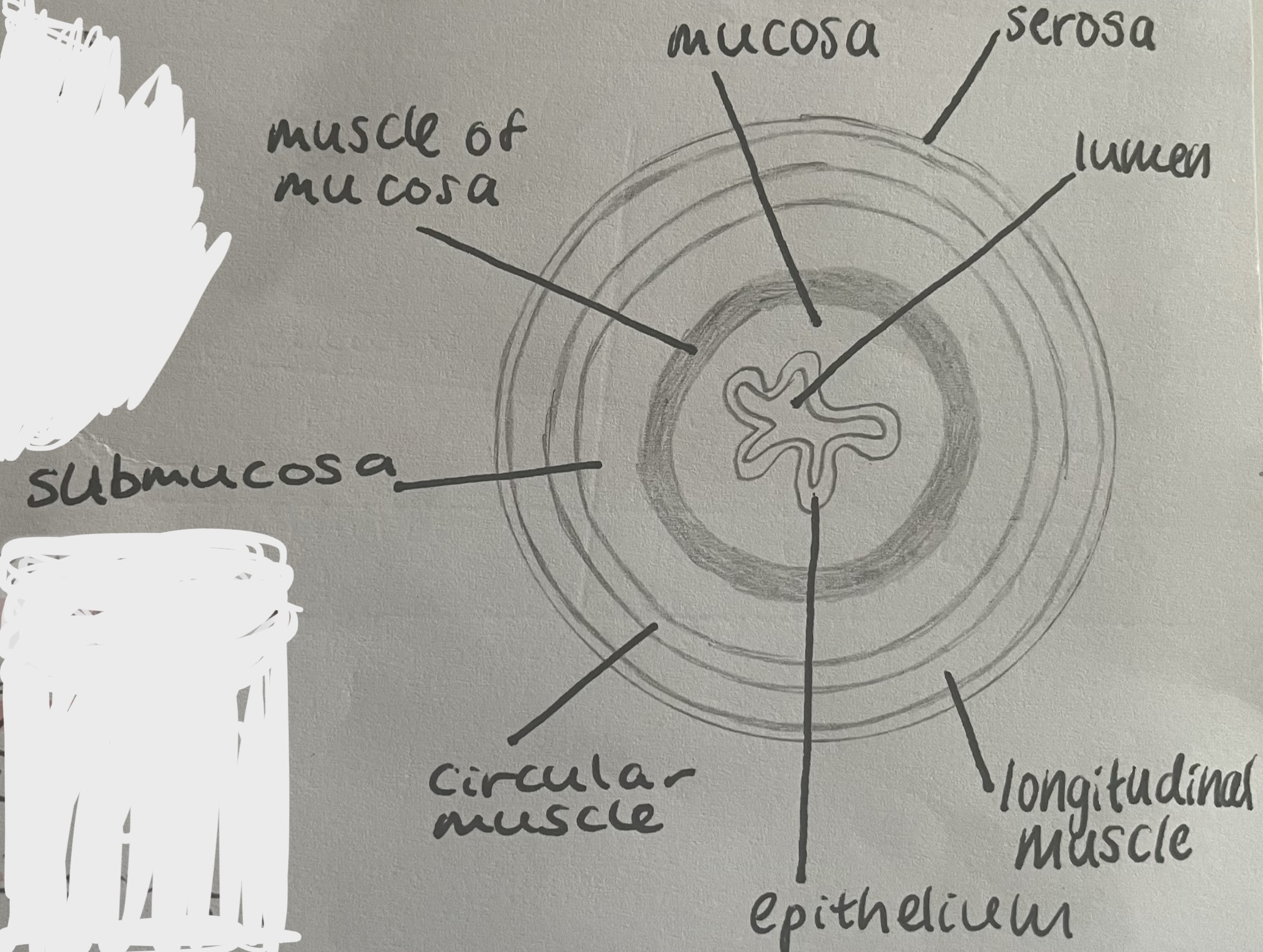
Structure of the gut wall
4 tissue layers surrounding the lumen
Muscle; 2 layers in different directions;
Circular muscles
Longitudinal muscles
Submucosa
Mucosa
Lumen
Structure and function of the lumen
Cavity of the gut
Structure and function of the Serosa in the gut wall
Tough, connective tissue protecting the gut wall
Reduces friction with other organs as gut moves while processing food
Structure and function of the Muscle in the gut wall
2 layers of muscle in different directions
Longitudinal muscles;
Relax, pushing the food along
Circular muscles;
Contract behind ball of food
Structure and function of Submucosa
Connective tissue containing blood and lymph vessels
Which remove absorbed products of digestion
Nerves coordinate peristalsis
Structure and function of Mucosa in the gut wall
Innermost layer
Lines the gut wall
Its epithelium secretes mucus
Lubricating and proctecting the mucosa
In some regions of the gut, it secretes digestive juices and in other absorbs digested food
Buccal cavity
Salivary glands secrete saliva which contains;
Amylase, beginning digestion of starch and glycogen to maltose which is hydrolysed further by maltase to alpha glucose
HCO3- and CO3- ions which neutralise pH and provide optimal. pH of saliva varies from 6.2-7.4. Optimum ~ 7.0
Mucus lubricates the food’s passage down the oesophagus
Tongue;
Has taste his
Helps manipulate the food in the mouth
Assists with swallowing
Teeth;
Break down food via mechanical digestion. Digestion into smaller pieces which increases surface area for substrate to come into contact with enzymes
Oesophagus
No role in digestion
Carries food to the stomach
Food passes through for a short period of time before reaching the stomach
No enzymes secreted
Wall of the Oesophagus

Stomach
food is churned (mechanical digestion) with gastric juice
Salivary amylase is denatured due to acidic pH
Bacteria consumed are killed by the acidic pH
Oblique muscle = extra muscle layer of muscle to help churn the contents of the stomach (chyme)
Gastric juice is secreted by from gastric pits
Very little absorption occurs but main site of alcohol absorption
Pepsinogen —(HCl)—> Pepsin
Proteins —(Pepsin)—> polypeptides/peptides
Stomach wall
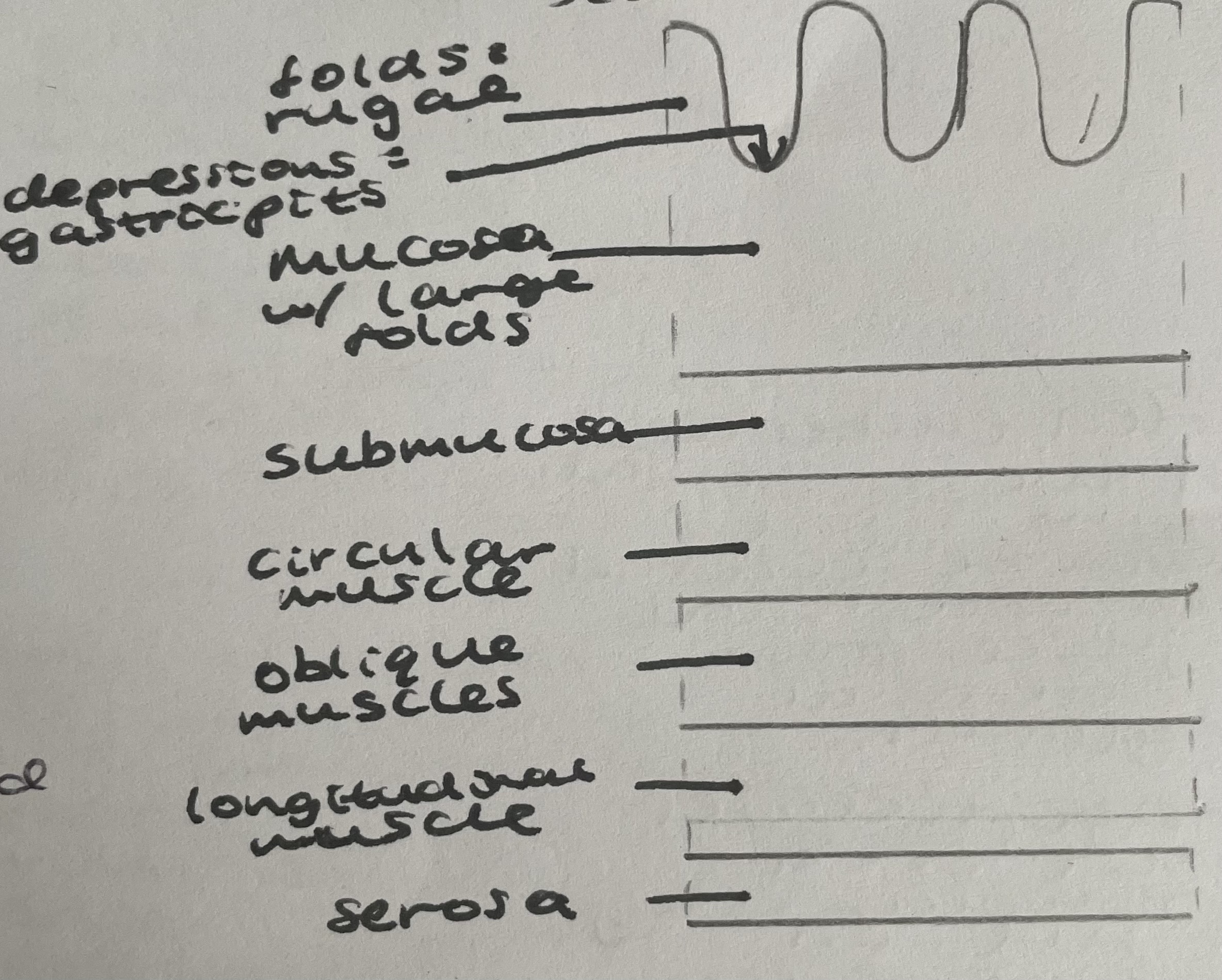
Oblique layer of muscle
Extra muscle layer within the stomach wall that helps to churn the contents of the stomach
Gastric Pit structure
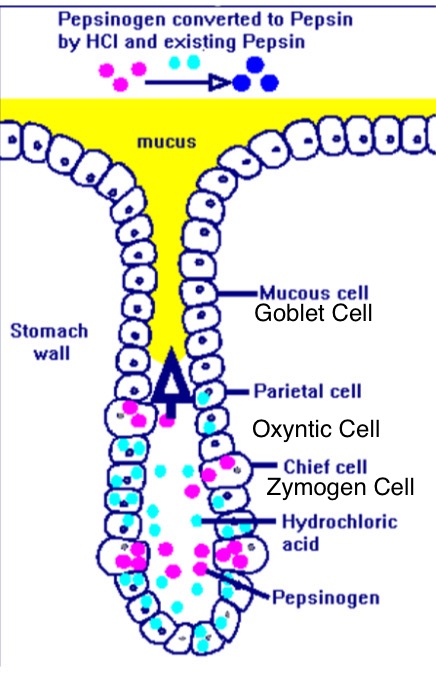
Gastric Juice
Zymogen/chief cells secrete the inactive enzyme pepsinogen. Pepsinogen is activated by H+ ions —> pepsin, an active endopeptidase which hydrolyses proteins into polypeptides
Oxyntic cells secrete the hydrochloric acid (HCl). Lowers pH of stomach contents —> 2; optimum pH for the enzymes and kills most bacteria in food
Goblet cells secrete mucus. Forms a lining which protects the stomach wall from the enzymes and lubricates the food
Proteases
Hydrolyses proteins into polypeptides, dipeptides and amino acids
Two types;
Endopeptidase
Exopeptidase
Endopeptidases
hydrolyse non-terminal peptide bonds within the protein/polypeptide molecules, adjacent to specific amino acids and form peptides
Exopeptidases
Can act after endos
Hydrolyse the terminal peptide bonds of the peptides, from the free amino end or the free carboxyl end
Small intestine
Duodenum
Ileum
Duodenum
first c shaped part of the si
Receives secretions from the pancreas and liver
Main role=digestion but also involved in absorbing nutrients
Pancreas empties pancreatic juice into the duodenum
Bile is made in the liver, stored in the gall bladder and emptied into the duodenum via the bile duct
Pancreatic juice
secreted by islet cells (exocrine glands in the pancreas)
Enters duodenum via pancreatic duct
Secretes at least one type of each digestive enzyme;
Pancreatic amylase; digests any remaining starch → maltose
Lipase; hydrolyses lipids → fatty acids and monoglycerides
Endopeptidases; hydrolyse proteins and polypeptides → peptides
Also contains trypsinogen;
Inactive precursors and endopeptidase
Activated by enterokinase (in pancreatic juice to activate trypsinogen)
Trypsinogen → trypsin
Trypsinogen -enterokinase→ trypsin
Polypeptides -trypsin→ shorter peptides
Also contains sodium hydrogen carbonate ions;
Raise the pH to make pancreatic juice and contributes to;
Neutralising acid from the stomach
Providing an appropriate pH for the pancreatic enzymes to work efficiently
optimum pH for all pancreatic enzymes ~ pH8
Trypsinogen
Inactive precursor of trypsin. Activated by enterokinase. Inactive otherwise it could digest the proteins of the cells which secrete it/the duodenum
Sodium hydrogen carbonate ions
raise the pH to make pancreatic juice and contribute to;
Neutralising acid from the stomach
Providing an appropriate pH for the pancreatic enzymes to work efficiently
Bile
Made in liver, stored in gall bladder and emptied into the duodenum via the bile duct
Contains no enzymes
Contains bile salts; Emulsify lipid globules by lowering surface tension and breaking up large globules into smaller globules therefore increasing S.A. and make digestion more effective by lipase
More hydrogen carbonate ions
Have hydrophobic and hydrophilic parts
Ileum
digestion that arts in the duodenum carries on into the ileum
Main role = absorption of products of digestion
Structure of Ileum
Has all layers in common with rest of gut but is adapted for efficient absorption of products of digestion
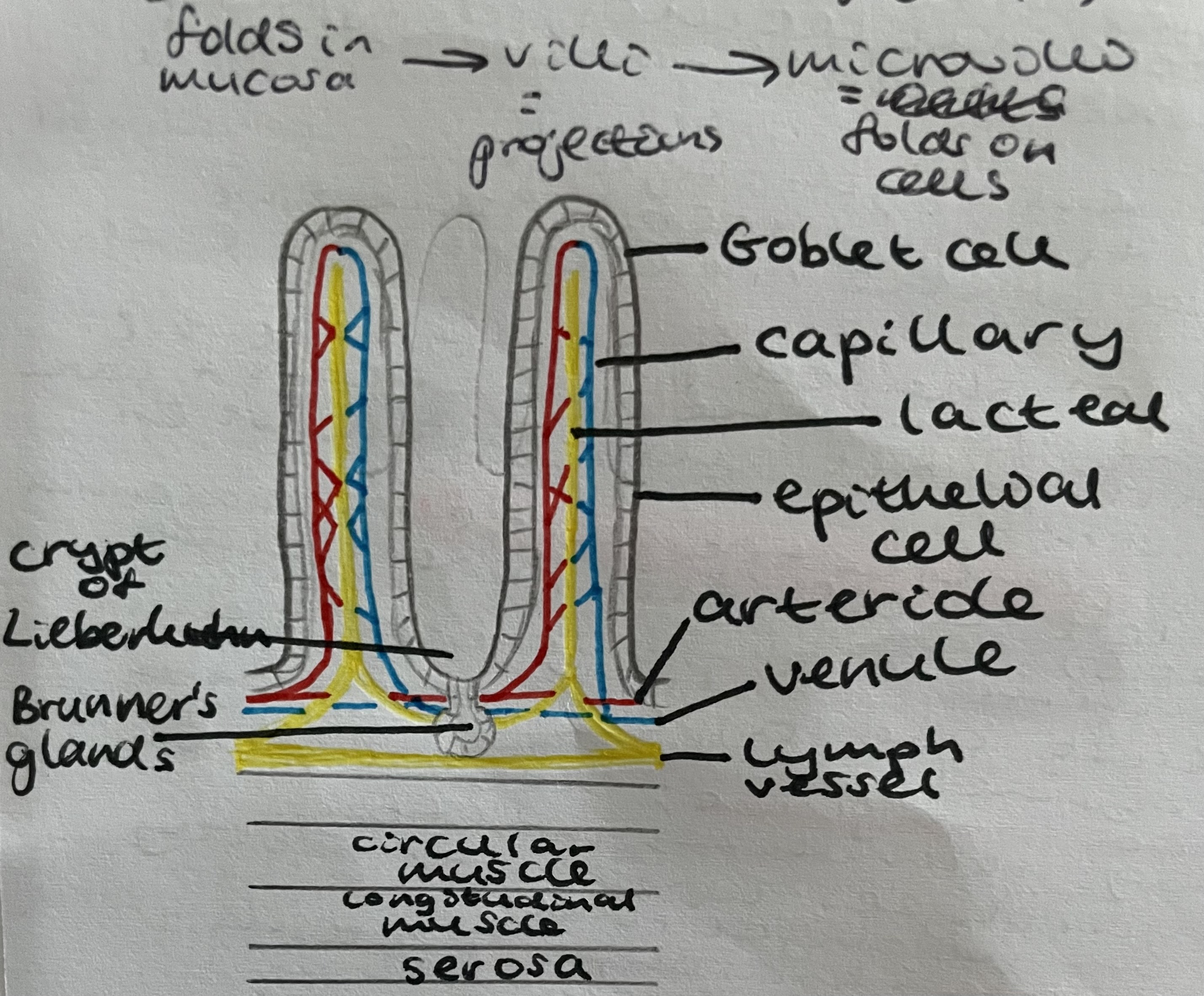
Adaptations of ileum for efficient absorption of products of digestion
Circular folds; finger-like projections = villi and infoldings of epithelial cell membranes = micro villi → large SA for absorption of nutrients and secretion of enzymes and increase SA for digestion of disaccharides and dipeptides as enzymes can embedded in the cell surface membranes
Good blood supply for transporting amino acids and glucose away and lacteals for transporting products of lipid digestion away → maintain concentration gradients
Walls of villi = 1 cell thick and network of capillaries → short diffusion pathway
Cells have many mitochondria → ATP synthesis for active transport
Many transport proteins within cell membranes
Circular and longitudinal muscles propel food by peristalsis and mix the contents, improving absorption
Goblet cells secrete muscle for lubrication of food
Brunner’s glands/intestinal glands/crypts of Lieberkuhn secrete alkaline intestinal juice which contains digestive enzymes
Epithelial cells of the small intestine
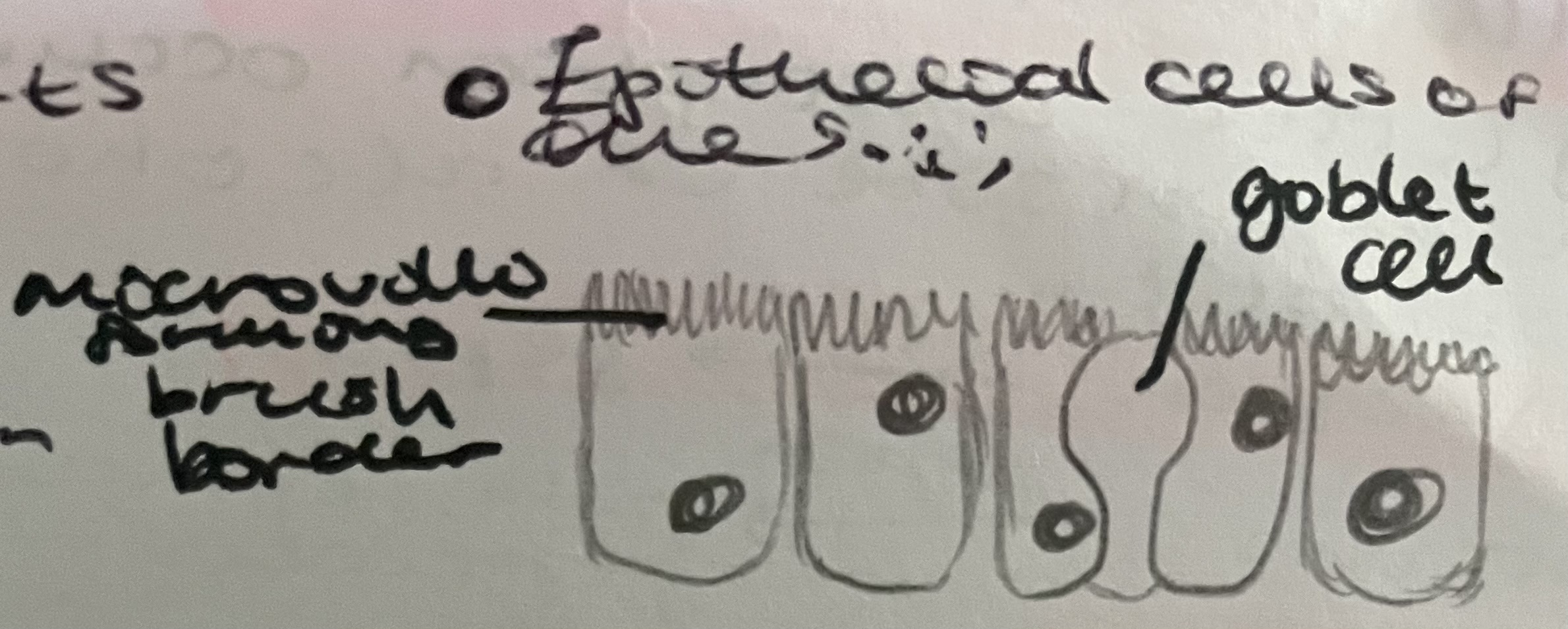
Secretions of the small intestine epithelial cells
Endo + exopeptidases;
Peptides secreted by villus epithelial cells and digestion continues on the gut lumen
Dipeptidases in the cell surface membranes digestion dipeptidases → amino acids
Carbohydrases;
Secreted and digestion continues in the gut lumen
Carbohydrases in the cell surface membranes digest disaccharides and monosaccharides
Some disaccharides are absorbed so their digestion = intracellular
often embedded in the epithelial cells which secrete surface membranes but can be secreted in intestinal juices from intestinal glands
Dipeptidases act in a similar way but on dipeptides
Trypsin, lipase and pancreatic amylase continue to act
Main mechanisms of absorption in the ileum
Diffusion, facilitated diffusion and active transport
The large intestine
Comprises the caecum, the appendix, the colon and the rectum
Colon
undigested food, mucus, bacteria and dead cells pass into the colon
Colon wall has fewer villi than the ileum
These villi have a major role in water absorption
Vitamin K and folic acid = secreted by mutualistic microorganisms living in the colon
Minerals absorbed from the colon
As material passes along the colon, water is absorbed
Structure of the wall of the colon

Substances absorbed in the ileum
glucose and other monosaccharides
Amino acids
Fats
Cholesterol and fat-soluble vitamins
Water-soluble vitamins
Mineral ions
Water
Absorption of glucose
Absorption of monosaccharides
Absorption of amino acids
Assimilation after absorption
Absorption of fats
Absorption of vitamins, water soluble vitamins,
Absorption in the large intestine
Egestion
Summary of absorption
Describe the process of glucose transport from the lumen of the small intestine into and then out of epithelial cells
Carnivore
Herbivore
Dentition of Herbivores
Dentition of Carnivores
Incisors in Herbivores
Canines in Herbivores
Diastema
Molars and premolars of Herbivores
Jaw of Herbivores
Muscles of Herbivores
Skull of Herbivores
Incisors of Herbivores
Canines of Herbivores
Carnassials
Jaw of Carnivores